2016 JEEP GRAND CHEROKEE fuel pressure
[x] Cancel search: fuel pressurePage 544 of 745

WARNING!(Continued)
•Always drive with each tire inflated to the recom-
mended cold tire inflation pressure.
Both under-inflation and over-inflation affect the stability
of the vehicle and can produce a feeling of sluggish
response or over responsiveness in the steering.
NOTE:
• Unequal tire pressures from side to side may cause
erratic and unpredictable steering response.
• Unequal tire pressure from side to side may cause the
vehicle to drift left or right.
Fuel Economy
Underinflated tires will increase tire rolling resistance
resulting in higher fuel consumption.
Tread Wear
Improper cold tire inflation pressures can cause abnor-
mal wear patterns and reduced tread life, resulting in the
need for earlier tire replacement.
Ride Comfort And Vehicle Stability
Proper tire inflation contributes to a comfortable ride.
Over-inflation produces a jarring and uncomfortable
ride.
Tire Inflation Pressures
The proper cold tire inflation pressure is listed on the
driver’s side B-Pillar or rear edge of the driver’s side
door.
542 STARTING AND OPERATING
Page 560 of 745

CAUTION!(Continued)
•After inspecting or adjusting the tire pressure,
always reinstall the valve stem cap. This will
prevent moisture and dirt from entering the valve
stem, which could damage the Tire Pressure Moni-
toring Sensor.
NOTE:
• The TPMS is not intended to replace normal tire care
and maintenance, or to provide warning of a tire
failure or condition.
• The TPMS should not be used as a tire pressure gauge
while adjusting your tire pressure. •
Driving on a significantly under-inflated tire causes
the tire to overheat and can lead to tire failure.
Under-inflation also reduces fuel efficiency and tire
tread life, and may affect the vehicle’s handling and
stopping ability.
• The TPMS is not a substitute for proper tire mainte-
nance, and it is the driver ’s responsibility to maintain
correct tire pressure using an accurate tire gauge, even
if under-inflation has not reached the level to trigger
illumination of the Tire Pressure Monitoring Telltale
Light.
• Seasonal temperature changes will affect tire pressure,
and the TPMS will monitor the actual tire pressure in
the tire.
558 STARTING AND OPERATING
Page 576 of 745
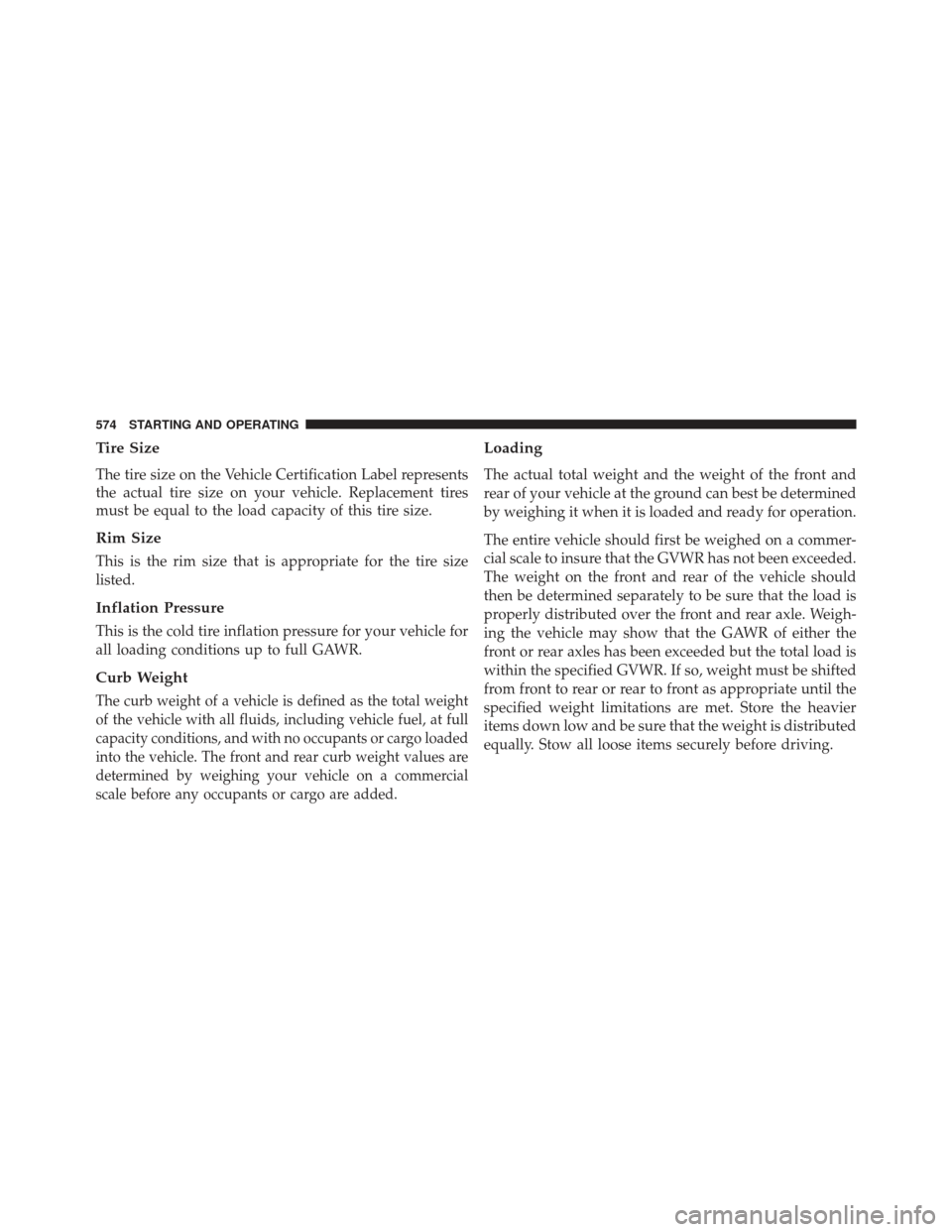
Tire Size
The tire size on the Vehicle Certification Label represents
the actual tire size on your vehicle. Replacement tires
must be equal to the load capacity of this tire size.
Rim Size
This is the rim size that is appropriate for the tire size
listed.
Inflation Pressure
This is the cold tire inflation pressure for your vehicle for
all loading conditions up to full GAWR.
Curb Weight
The curb weight of a vehicle is defined as the total weight
of the vehicle with all fluids, including vehicle fuel, at full
capacity conditions, and with no occupants or cargo loaded
into the vehicle. The front and rear curb weight values are
determined by weighing your vehicle on a commercial
scale before any occupants or cargo are added.
Loading
The actual total weight and the weight of the front and
rear of your vehicle at the ground can best be determined
by weighing it when it is loaded and ready for operation.
The entire vehicle should first be weighed on a commer-
cial scale to insure that the GVWR has not been exceeded.
The weight on the front and rear of the vehicle should
then be determined separately to be sure that the load is
properly distributed over the front and rear axle. Weigh-
ing the vehicle may show that the GAWR of either the
front or rear axles has been exceeded but the total load is
within the specified GVWR. If so, weight must be shifted
from front to rear or rear to front as appropriate until the
specified weight limitations are met. Store the heavier
items down low and be sure that the weight is distributed
equally. Stow all loose items securely before driving.
574 STARTING AND OPERATING
Page 640 of 745
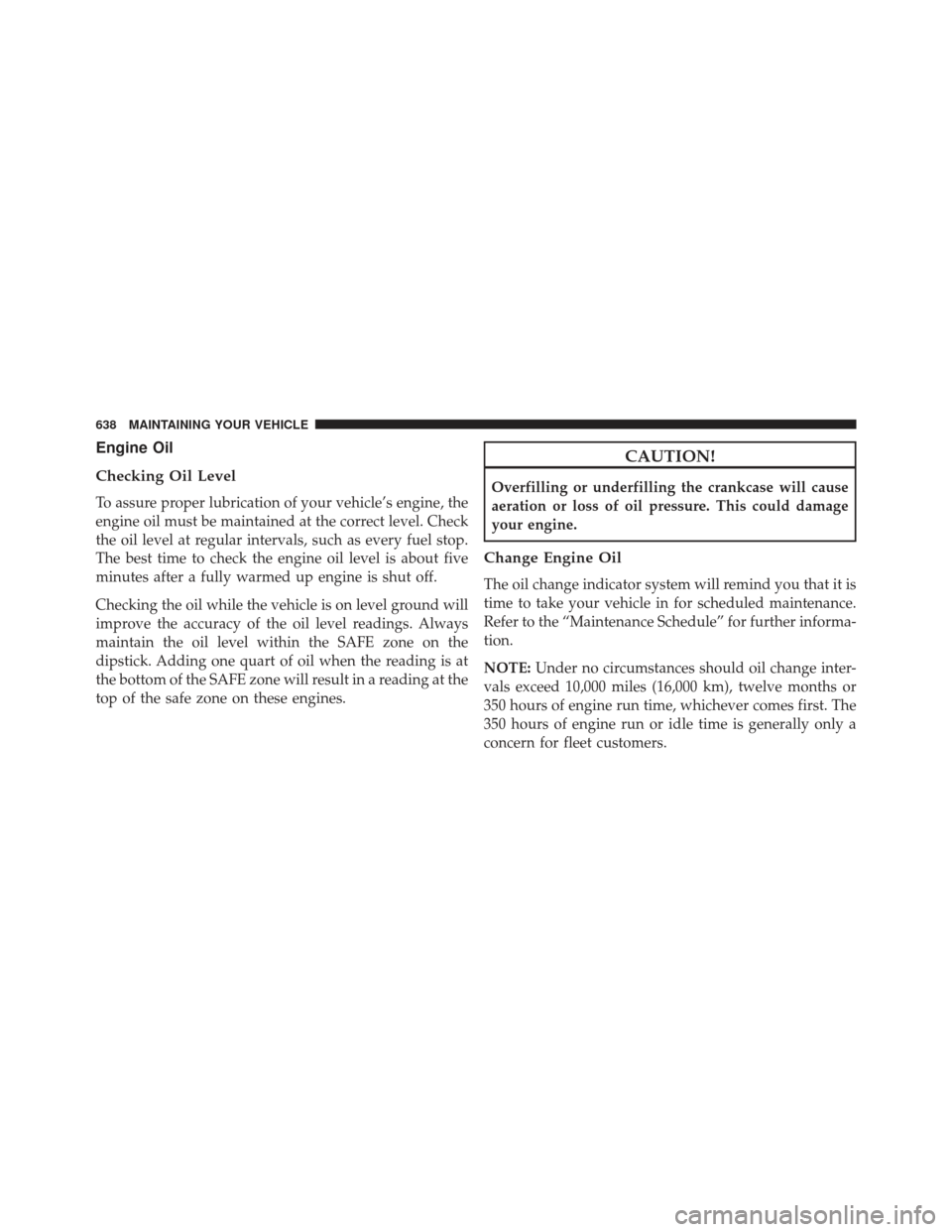
Engine Oil
Checking Oil Level
To assure proper lubrication of your vehicle’s engine, the
engine oil must be maintained at the correct level. Check
the oil level at regular intervals, such as every fuel stop.
The best time to check the engine oil level is about five
minutes after a fully warmed up engine is shut off.
Checking the oil while the vehicle is on level ground will
improve the accuracy of the oil level readings. Always
maintain the oil level within the SAFE zone on the
dipstick. Adding one quart of oil when the reading is at
the bottom of the SAFE zone will result in a reading at the
top of the safe zone on these engines.
CAUTION!
Overfilling or underfilling the crankcase will cause
aeration or loss of oil pressure. This could damage
your engine.
Change Engine Oil
The oil change indicator system will remind you that it is
time to take your vehicle in for scheduled maintenance.
Refer to the “Maintenance Schedule” for further informa-
tion.
NOTE:Under no circumstances should oil change inter-
vals exceed 10,000 miles (16,000 km), twelve months or
350 hours of engine run time, whichever comes first. The
350 hours of engine run or idle time is generally only a
concern for fleet customers.
638 MAINTAINING YOUR VEHICLE
Page 706 of 745
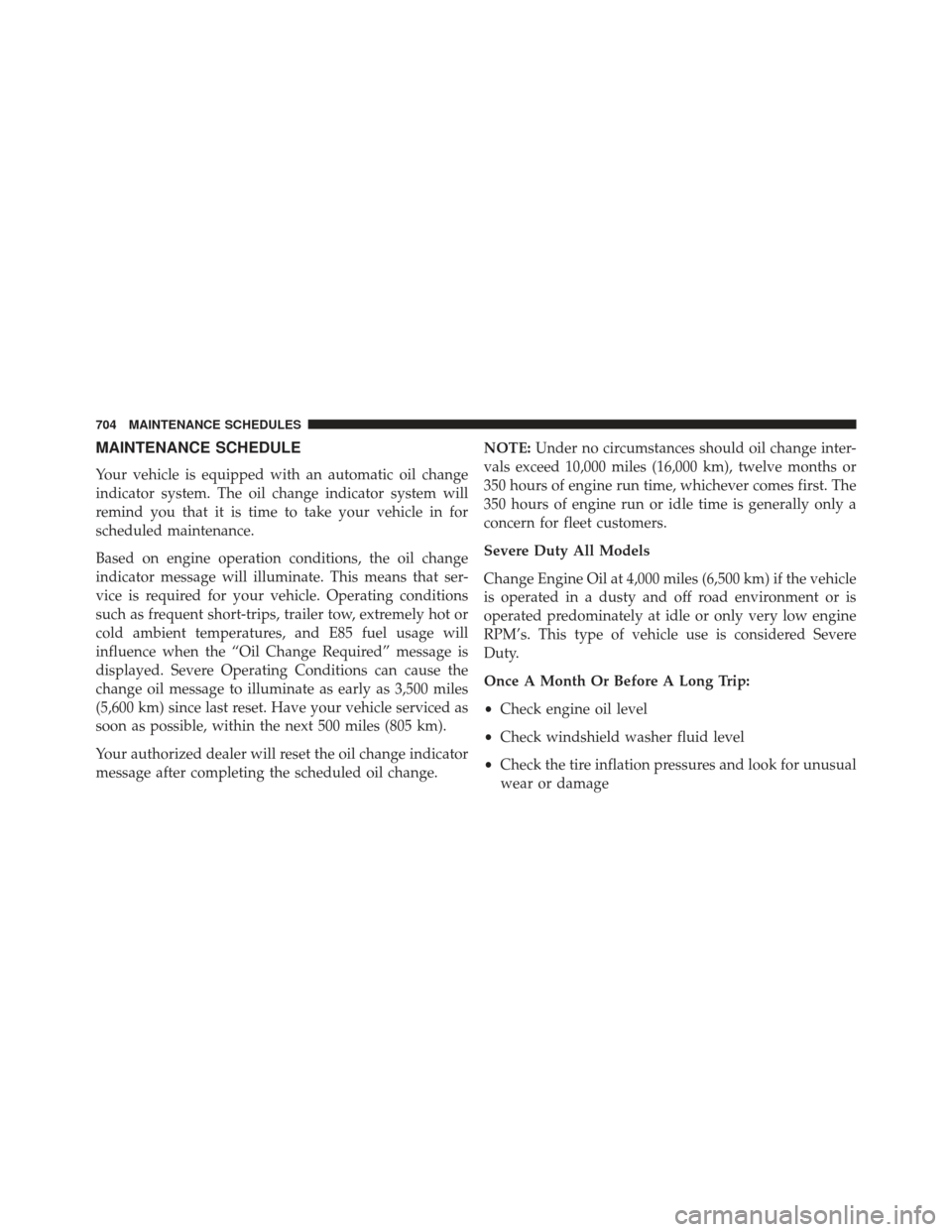
MAINTENANCE SCHEDULE
Your vehicle is equipped with an automatic oil change
indicator system. The oil change indicator system will
remind you that it is time to take your vehicle in for
scheduled maintenance.
Based on engine operation conditions, the oil change
indicator message will illuminate. This means that ser-
vice is required for your vehicle. Operating conditions
such as frequent short-trips, trailer tow, extremely hot or
cold ambient temperatures, and E85 fuel usage will
influence when the “Oil Change Required” message is
displayed. Severe Operating Conditions can cause the
change oil message to illuminate as early as 3,500 miles
(5,600 km) since last reset. Have your vehicle serviced as
soon as possible, within the next 500 miles (805 km).
Your authorized dealer will reset the oil change indicator
message after completing the scheduled oil change.NOTE:
Under no circumstances should oil change inter-
vals exceed 10,000 miles (16,000 km), twelve months or
350 hours of engine run time, whichever comes first. The
350 hours of engine run or idle time is generally only a
concern for fleet customers.
Severe Duty All Models
Change Engine Oil at 4,000 miles (6,500 km) if the vehicle
is operated in a dusty and off road environment or is
operated predominately at idle or only very low engine
RPM’s. This type of vehicle use is considered Severe
Duty.
Once A Month Or Before A Long Trip:
• Check engine oil level
• Check windshield washer fluid level
• Check the tire inflation pressures and look for unusual
wear or damage
704 MAINTENANCE SCHEDULES
Page 724 of 745
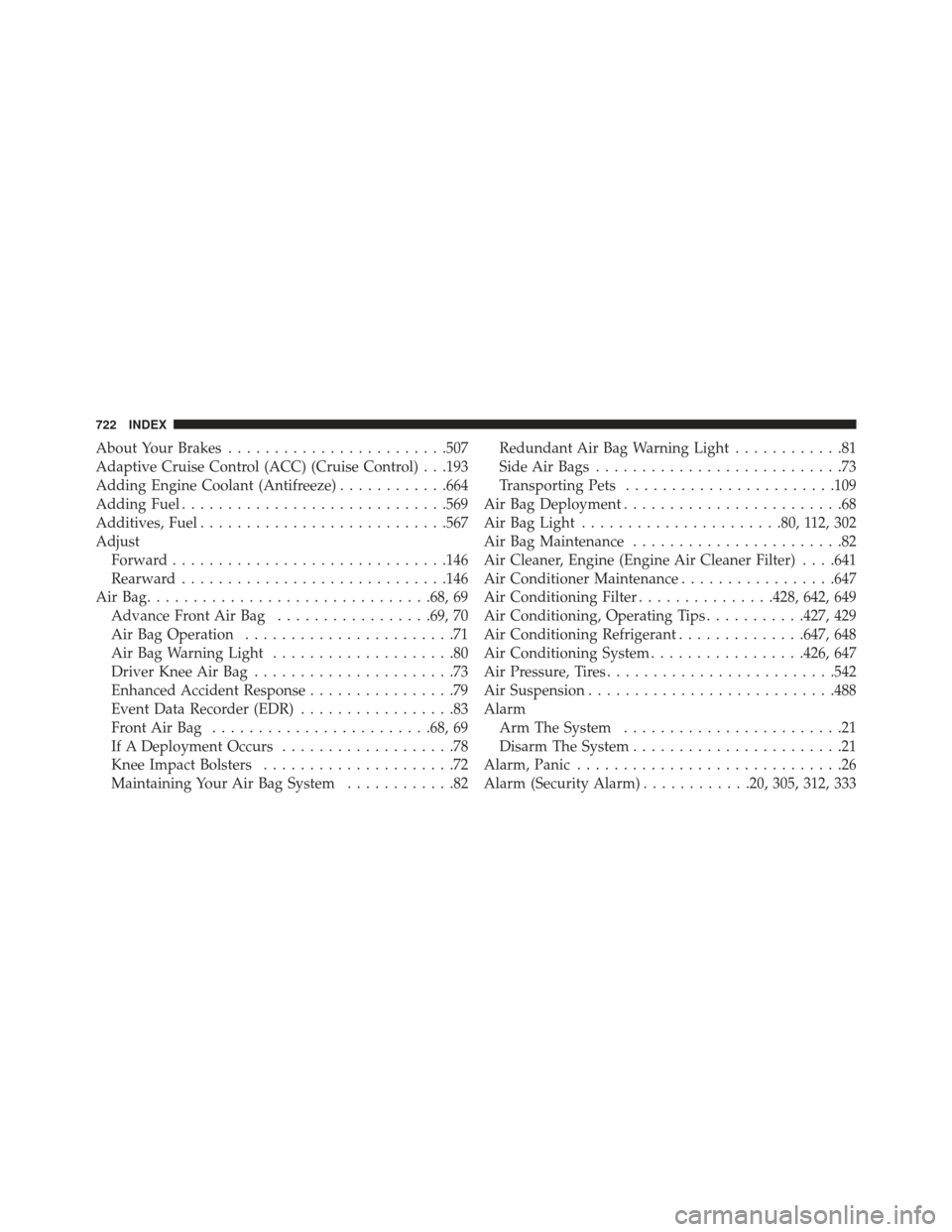
About Your Brakes....................... .507
Adaptive Cruise Control (ACC) (Cruise Control) . . .193
Adding Engine Coolant (Antifreeze) ............664
Adding Fuel ............................ .569
Additives, Fuel .......................... .567
Adjust Forward ............................. .146
Rearward ............................ .146
AirBag.............................. .68, 69
Advance Front Air Bag .................69, 70
Air Bag Operation .......................71
Air Bag Warning Light ....................80
Driver Knee Air Bag ......................73
Enhanced Accident Response ................79
Event Data Recorder (EDR) .................83
FrontAirBag ........................68, 69
If A Deployment Occurs ...................78
Knee Impact Bolsters .....................72
Maintaining Your Air Bag System ............82Redundant Air Bag Warning Light
............81
Side Air Bags ...........................73
Transporting Pets ...................... .109
Air Bag Deployment ........................68
Air Bag Light ..................... .80, 112, 302
Air Bag Maintenance .......................82
Air Cleaner, Engine (Engine Air Cleaner Filter) . . . .641
Air Conditioner Maintenance .................647
Air Conditioning Filter ...............428, 642, 649
Air Conditioning, Operating Tips ...........427, 429
Air Conditioning Refrigerant ..............647, 648
Air Conditioning System .................426, 647
Air Pressure, Tires ........................ .542
Air Suspension .......................... .488
Alarm Arm The System ........................21
Disarm The System .......................21
Alarm, Panic .............................26
Alarm (Security Alarm) ............20, 305, 312, 333
722 INDEX
Page 733 of 745

Liftgate.................................47
Liftgate Window Wiper/Washer ...............288
Light Bulbs ..............................114
Lights ..............................114,169
AirBag ........................80, 112, 302
Automatic Headlights ....................170
Back-Up ............................. .694
Brake Assist Warning ....................518
Brake Warning ........................ .303
Bulb Replacement ...................... .691
Cargo .............................. .283
Center Mounted Stop ....................697
Cruise ........................... .328, 331
Daytime Running ...................... .172
Dimmer Switch, Headlight .................169
Engine Temperature Warning ...............307
Exterior ..............................114
Fog ................................ .693
Hazard Warning Flasher ..................600 Headlights
........................... .692
Headlights On With Wipers ................170
Hill Descent Control Indicator ..............522
Illuminated Entry ........................23
Low Fuel ............................ .321
Malfunction Indicator (Check Engine) .........314
Map Reading ......................... .176
Park ............................ .326, 328
Passing ............................. .179
Reading .......................... .176, 252
Rear Servicing ........................ .694
Rear Tail Lamps ....................... .694
Seat Belt Reminder ..................... .301
Security Alarm ........................ .305
Service .............................. .691
Side Marker .......................... .694
Tire Pressure Monitoring (TPMS) ............317
Traction Control ....................... .518
T
urn Signal ..............114, 169, 327, 693, 694
10
INDEX 731
Page 735 of 745
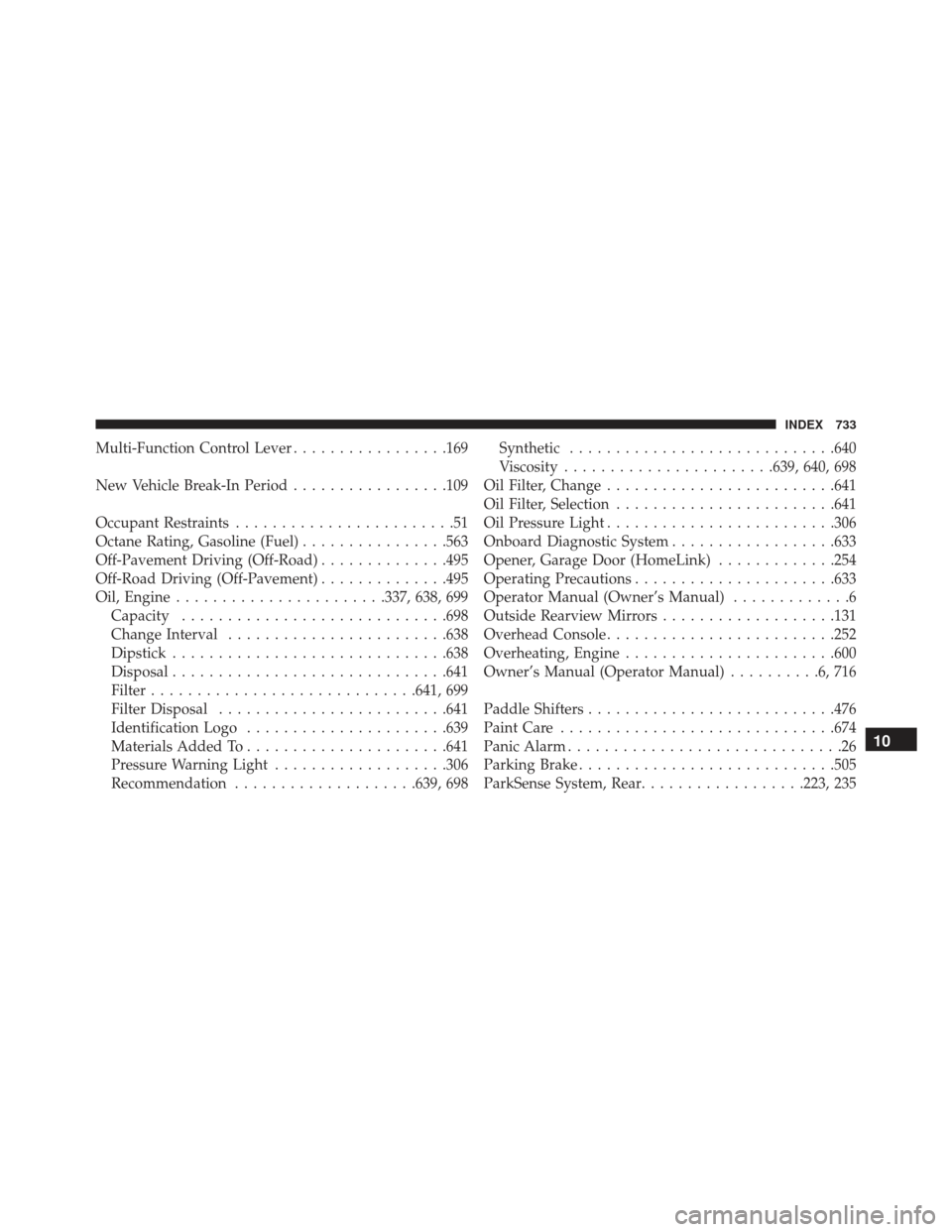
Multi-Function Control Lever.................169
New Vehicle Break-In Period .................109
Occupant Restraints ........................51
Octane Rating, Gasoline (Fuel) ................563
Off-Pavement Driving (Off-Road) ..............495
Off-Road Driving (Off-Pavement) ..............495
Oil, Engine ...................... .337, 638, 699
Capacity ............................ .698
Change Interval ....................... .638
Dipstick ............................. .638
Disposal ............................. .641
Filter ............................ .641, 699
Filter Disposal ........................ .641
Identification Logo ..................... .639
Materials Added To ..................... .641
Pressure Warning Light ...................306
Recommendation ....................639, 698 Synthetic
............................ .640
Viscosity ...................... .639, 640, 698
Oil Filter, Change ........................ .641
Oil Filter, Selection ....................... .641
Oil Pressure Light ........................ .306
Onboard Diagnostic System ..................633
Opener, Garage Door (HomeLink) .............254
Operating Precautions ..................... .633
Operator Manual (Owner’s Manual) .............6
Outside Rearview Mirrors ...................131
Overhead Console ........................ .252
Overheating, Engine ...................... .600
Owner’s Manual (Operator Manual) ..........6,716
Paddle Shifters .......................... .476
Paint Care ............................. .674
Panic Alarm ..............................26
Parking Brake ........................... .505
ParkSense System, Rear ..................223, 235
10
INDEX 733